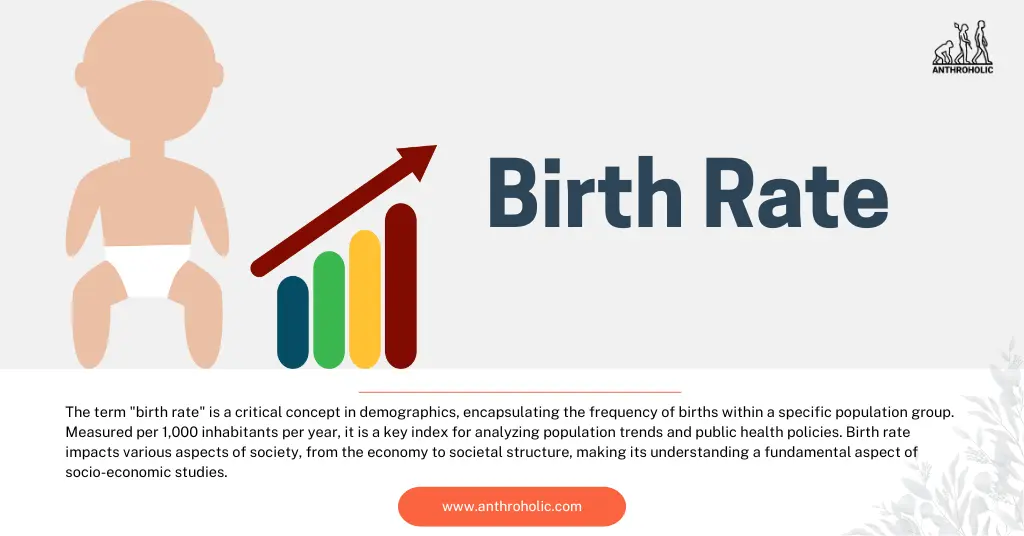AI Answer Evaluation Platform Live Now. Try Free Answer Evaluation Now
Birth Rate
The term “birth rate” is a critical concept in demographics, encapsulating the frequency of births within a specific population group. Measured per 1,000 inhabitants per year, it is a key index for analyzing population trends and public health policies. Birth rate impacts various aspects of society, from the economy to societal structure, making its understanding a fundamental aspect of socio-economic studies.

The Concept of Birth Rate
Definition and Calculation
Birth rate, also referred to as crude birth rate, quantifies the annual number of live births per 1,000 individuals in a population [1]. The formula is:
Birth Rate = (Total Number of Births / Total Population) x 1,000
The resulting figure is typically expressed as a per mille figure. For instance, a birth rate of 10 means that there are 10 births annually for every 1,000 people in the population [2].
Types of Birth Rate
Birth rates can be further categorized into two distinct types [3]:
- General Birth Rate: This measures the number of live births per 1,000 individuals in a population in a year.
- Age-Specific Birth Rate: This calculates the number of live births per 1,000 women in a specific age group in a year.
Factors Affecting Birth Rate
The birth rate of a population can be influenced by various factors, each with varying degrees of impact [4]:
- Economic Conditions: Economically stable societies tend to have lower birth rates. In contrast, impoverished regions often have higher birth rates due to lack of access to family planning services and education.
- Cultural and Religious Beliefs: Societies with cultural or religious preferences for larger families often exhibit higher birth rates.
- Education and Literacy Levels: Higher education levels, particularly among women, correlate with lower birth rates.
- Healthcare Access: Access to reproductive healthcare, including contraception, typically results in lower birth rates.
- Government Policies: Policies promoting family planning or providing child benefits can significantly influence birth rates.
Global Birth Rate Trends
In the past few decades, there has been a general trend towards decreasing birth rates globally. This has been particularly evident in developed countries where birth rates have fallen below the replacement level of 2.1 children per woman.
| Country | Birth Rate (2022) | Birth Rate (2023) |
|---|---|---|
| Japan | 7.3 | 7.1 |
| Germany | 9.4 | 9.2 |
| USA | 11.6 | 11.4 |
| India | 18.2 | 17.9 |
| Nigeria | 35.7 | 35.3 |
(Source: United Nations, Department of Economic and Social Affairs, Population Division [5])
This decline is attributable to improvements in healthcare, increased female participation in the labor force, and shifts in societal attitudes towards family size.
Implications of Birth Rate Changes
The shift in birth rates has profound implications:
- Economic Impact: Lower birth rates can lead to labor shortages, potentially hampering economic growth [6].
- Demographic Shift: Aging populations become more prevalent with lower birth rates, posing challenges to social security systems and healthcare infrastructure.
- Environmental Implications: Lower birth rates could help manage resource scarcity and mitigate climate change impacts [7].
Conclusion
Understanding birth rate and its implications is crucial for policymakers, economists, and social scientists. By studying birth rate trends and their contributing factors, societies can better plan for future challenges and capitalize on emerging opportunities.
References
[1] United Nations, Department of Economic and Social Affairs, Population Division (2019). World Population Prospects.
[2] Preston, Samuel H.; Heuveline, Patrick; Guillot, Michel (2001). Demography: Measuring and Modeling Population Processes.
[3] Poston, D.L. & Bouvier, L.F. (2010). Population and Society: An Introduction to Demography.
[4] Bongaarts, John (1998). “Demographic Consequences of Declining Fertility”. Science.
[5] United Nations, Department of Economic and Social Affairs, Population Division (2023). World Population Prospects.
[6] Bloom, D.E., Canning, D., & Sevilla, J. (2003). The Demographic Dividend: A New Perspective on the Economic Consequences of Population Change.
[7] Dasgupta, P. (2009). The Population Problem: Theory and Evidence. Journal of Economic Literature.




